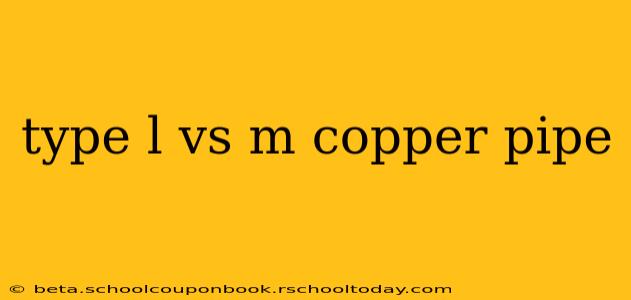Choosing the right type of copper pipe is crucial for any plumbing project, ensuring durability, efficiency, and longevity. Two common types, Type L and Type M, often leave homeowners and contractors wondering which is best suited for their needs. This comprehensive guide will delve into the key differences between Type L and Type M copper pipes, helping you make an informed decision.
What are Type L and Type M Copper Pipes?
Both Type L and Type M copper pipes are widely used in plumbing systems for their excellent corrosion resistance, durability, and ease of installation. The primary difference lies in their wall thickness:
-
Type L Copper Pipe: This is the thickest of the standard copper pipe types, offering superior strength and pressure resistance. Its thicker walls make it ideal for applications requiring high pressure or demanding environments.
-
Type M Copper Pipe: Type M copper pipe has a thinner wall than Type L, making it lighter and easier to handle during installation. It’s a cost-effective option suitable for many residential plumbing applications.
What is the difference in wall thickness between Type L and Type M copper pipes?
The difference in wall thickness is significant. Type L copper pipe has a heavier wall thickness, leading to greater strength and pressure-handling capabilities compared to Type M. While exact measurements vary slightly based on the pipe's diameter, the difference is consistently notable. This difference is key to understanding their respective applications.
Which is stronger, Type L or Type M copper pipe?
Type L copper pipe is stronger than Type M. Its thicker walls provide superior resistance to pressure fluctuations and potential damage from impacts or bending. This makes it the preferred choice for high-pressure applications, underground installations, and areas prone to seismic activity.
Which type of copper pipe is cheaper, Type L or Type M?
Type M copper pipe is generally cheaper than Type L. This is primarily due to its thinner wall, requiring less copper material in its construction. The lower material cost translates to a lower price point, making it an attractive option for budget-conscious projects.
What are the uses of Type L and Type M copper pipes?
The application of each pipe type depends largely on the project’s requirements:
-
Type L Copper Pipe Uses: High-pressure applications, underground installations, large-diameter lines, and situations demanding superior strength and durability. It's often used in commercial settings and where safety and longevity are paramount.
-
Type M Copper Pipe Uses: Residential plumbing systems, above-ground installations, areas with lower pressure requirements, and projects where cost-effectiveness is a priority. It's a popular choice for household water supply and drainage systems.
When should I use Type L copper pipe?
Use Type L copper pipe when:
- High pressure is anticipated.
- The installation is underground.
- The application requires exceptional durability and strength.
- You need a long-lasting solution with minimal risk of failure.
- The application is in a demanding environment (e.g., harsh weather conditions).
When should I use Type M copper pipe?
Use Type M copper pipe when:
- You need a cost-effective solution.
- The pressure demands are relatively low (typical residential applications).
- The installation is above ground.
- The application is in a stable and non-aggressive environment.
Can I use Type M copper pipe where Type L is specified?
No, you should not substitute Type M copper pipe for Type L where Type L is specified in building codes or project plans. Doing so compromises the structural integrity and safety of the plumbing system, potentially leading to leaks, failures, and costly repairs. Always adhere to local building codes and the project specifications.
What are the pros and cons of each type?
Type L Copper Pipe:
Pros: High strength, pressure resistance, durability, long lifespan. Cons: More expensive, heavier, slightly more difficult to install.
Type M Copper Pipe:
Pros: Cost-effective, lighter weight, easier to install. Cons: Lower strength, less pressure resistance than Type L, not suitable for all applications.
By carefully considering the specific demands of your project and weighing the pros and cons of each pipe type, you can ensure you select the most appropriate and reliable copper pipe for the job. Remember to always consult local building codes and professional advice when planning your plumbing installation.
